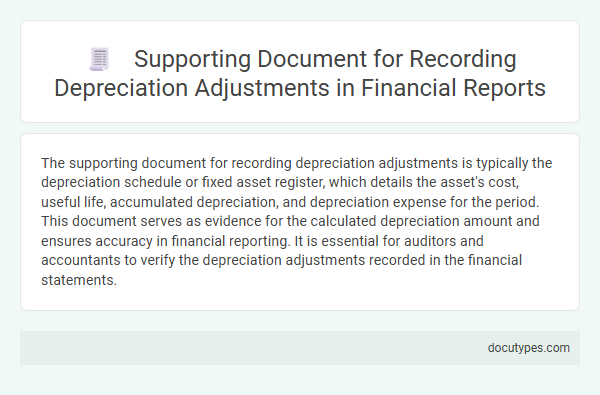The supporting document for recording depreciation adjustments is typically the depreciation schedule or fixed asset register, which details the asset's cost, useful life, accumulated depreciation, and depreciation expense for the period. This document serves as evidence for the calculated depreciation amount and ensures accuracy in financial reporting. It is essential for auditors and accountants to verify the depreciation adjustments recorded in the financial statements.
Introduction to Depreciation Adjustments
Depreciation adjustments reflect changes in the value of fixed assets over time, ensuring that financial statements accurately represent asset conditions. Supporting documents provide evidence and justification for these adjustments, maintaining transparency and compliance with accounting standards.
- Depreciation Schedule - A detailed record showing the asset's purchase date, cost, useful life, and accumulated depreciation, which guides the adjustment process.
- Asset Valuation Reports - Professional assessments that verify the current value of an asset, supporting any changes in depreciation expense.
- Maintenance and Usage Records - Documents detailing asset usage and upkeep that can impact depreciation calculations and adjustment justifications.
Importance of Supporting Documents
Supporting documents for recording depreciation adjustments are essential for verifying the accuracy and legitimacy of the reported asset values. These documents typically include asset purchase invoices, depreciation schedules, and maintenance records, which provide a clear audit trail. Proper documentation ensures compliance with accounting standards and facilitates accurate financial reporting for stakeholders.
Types of Depreciation Methods
Supporting documents for recording depreciation adjustments include detailed records of the depreciation method applied and asset cost data. Common depreciation methods are straight-line, declining balance, and units of production, each requiring specific calculation details to validate adjustments. You should ensure thorough documentation to align with the chosen depreciation approach and maintain accurate financial records.
Required Supporting Documents
Supporting documents for recording depreciation adjustments are essential to ensure accuracy and compliance in financial reporting. These documents provide validation and justification for the adjustments made to asset values over time.
Required supporting documents typically include the fixed asset register, which details the original cost and accumulated depreciation of each asset. Depreciation schedules outlining the method and rate applied play a crucial role. Additionally, asset valuation reports or appraisal documents may be needed to support changes in depreciation amounts.
Documentation for Asset Acquisition
| Aspect | Details |
|---|---|
| Supporting Document for Recording Depreciation Adjustments | Documentation verifying asset acquisition cost, useful life, and depreciation method. |
| Primary Document Type | Invoice or Purchase Order for the asset acquisition. |
| Additional Documentation | Asset register entry, asset appraisal reports, and approval authorizations. |
| Purpose | Validate asset's cost basis and acquisition date to ensure accurate depreciation calculations. |
| Relevance to Depreciation Adjustments | Confirms the initial recorded value before adjustments; supports revision of depreciation expense. |
| Required Information | Asset description, acquisition date, purchase price, vendor details, and condition at acquisition. |
| Regulatory Compliance | Supports adherence to accounting standards such as GAAP or IFRS for asset management. |
Evidence for Depreciation Calculations
What is the supporting document for recording depreciation adjustments? The primary evidence for depreciation calculations includes asset purchase invoices and depreciation schedules, which validate the asset's cost and useful life. You should also retain maintenance records and previous depreciation reports to ensure accuracy and compliance.
Recording Depreciation in Financial Reports
Recording depreciation adjustments is essential for accurate financial reporting and asset valuation. Supporting documents ensure transparency and compliance with accounting standards.
- Depreciation Schedule - A detailed plan showing the allocation of an asset's cost over its useful life.
- Asset Register - A record of all company assets including purchase dates and costs used to verify depreciation.
- Accounting Journal Entries - Official records that document the depreciation expense recorded for each accounting period.
Your financial reports rely on these supporting documents to validate depreciation adjustments and maintain audit readiness.
Internal Controls and Audit Trail
Supporting documents for recording depreciation adjustments are essential for maintaining internal controls and ensuring an accurate audit trail. These documents validate the adjustments and provide transparency throughout the accounting process.
- Depreciation Schedule - Detailed records outlining the asset's depreciation method, useful life, and accumulated depreciation.
- Asset Register - Comprehensive list of fixed assets with acquisition dates and values to support depreciation calculations.
- Approval Authorization - Formal sign-off from management or accounting personnel confirming the accuracy of the adjustments.
Compliance with Accounting Standards
The supporting document for recording depreciation adjustments is typically the depreciation schedule or fixed asset register. This document provides detailed information on asset cost, useful life, residual value, and accumulated depreciation, ensuring accuracy in financial records.
Compliance with accounting standards such as IFRS or GAAP requires maintaining this documentation to substantiate depreciation entries. Your depreciation adjustments must be backed by these records to meet audit requirements and ensure transparent financial reporting.
What Is the Supporting Document for Recording Depreciation Adjustments? Infographic

